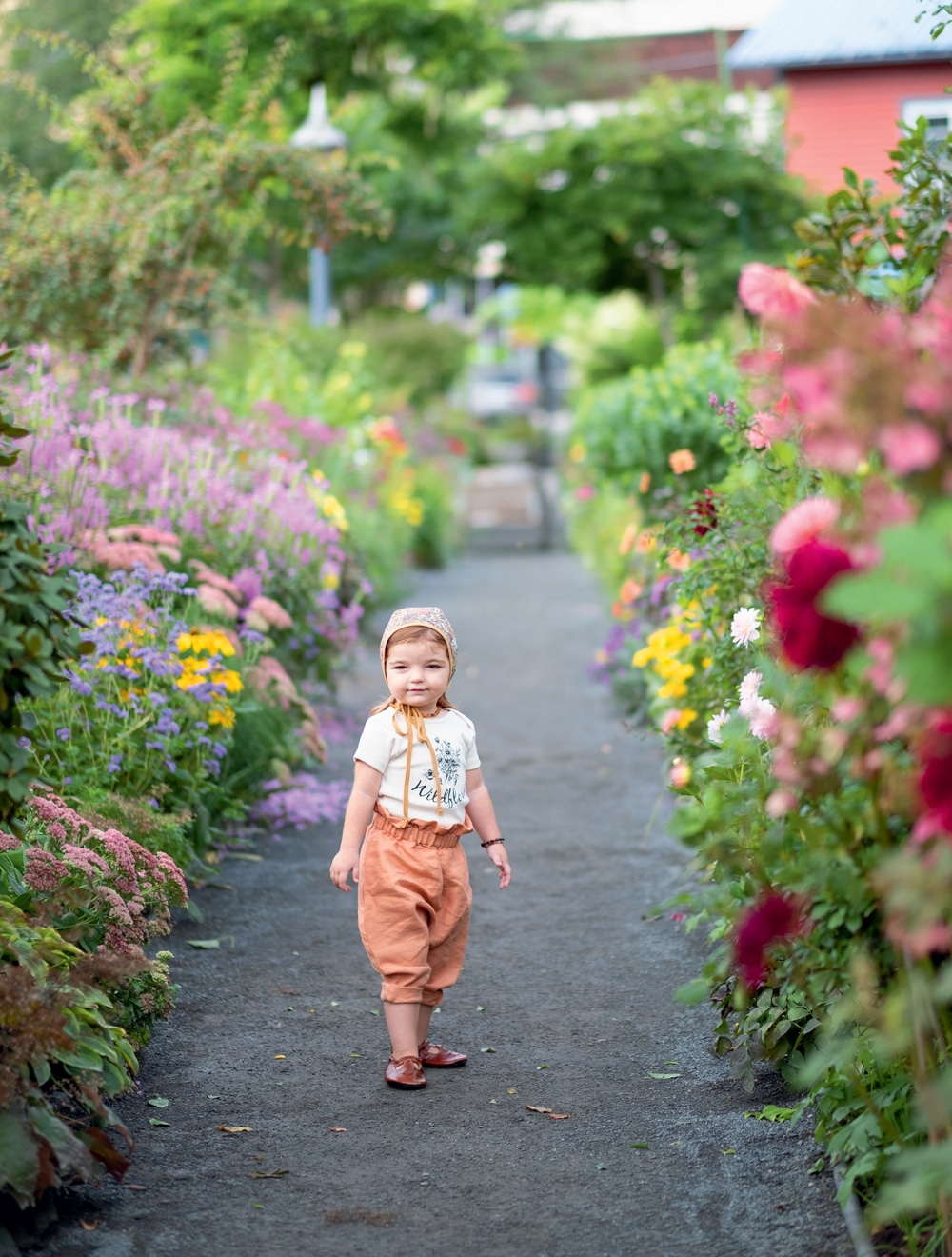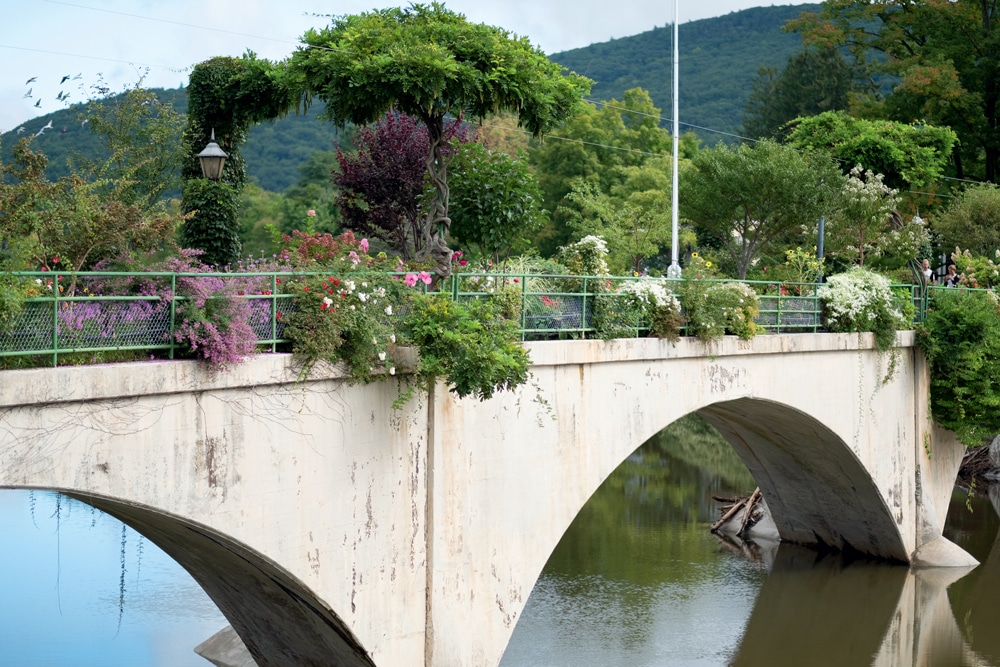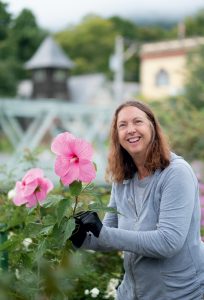A Bridge for Dreamers | First Light
Reimagined as a garden in the sky, a former trolley span over the Deerfield River still has the ability to transport visitors.

Coffee By Design | Portland, Maine
Photo Credit : Katherine Keenan
Photo Credit : Heather Marcus
If you’re driving Route 2, Massachusetts’s famed Mohawk Trail, keep an eye out for the sign pointing to the village of Shelburne Falls, about 10 miles west of Greenfield. Make the turn, and soon you’ll forget why you were in a hurry to go anywhere else. From the moment you step onto the 400-foot-long Bridge of Flowers connecting the towns of Shelburne and Buckland, the world will seem to slow.

Photo Credit : Heather Marcus
Black-eyed Susans wink, turtleheads nod. Clematis tendrils reach for the next fence link. Hibiscuses wave frilly skirts against hearty circles of sedum. Flowering kale’s maze of folds look good enough to eat—at least that’s the buzz from the bees zipping past, and the swallows alighting on a nearby bench. Hundreds of flowers, vines, shrubs, and trees edge the path. From early spring to late autumn, some 30,000 garden lovers stroll this former trolley bridge, their senses alive, while the Deerfield River flows past below.
Gardening atop a river wasn’t the goal when the Shelburne Falls & Colrain Street Railway constructed the 18-foot-wide all-concrete bridge in 1908 as a stronger option than the existing 1890 iron truss bridge. The company went bankrupt in 1927, and soon weeds overtook the concrete bridge. But a local homemaker, Antoinette Burnham, saw what others did not. She imagined a gorgeous reuse for a structure deemed too expensive to demolish and, with its water main, too complicated to destroy. The Shelburne Falls Fire District purchased the bridge in 1928 for $1,250 (a steal, given that the $20,000 construction price tag today equals nearly $300,000), and in 1929 the nonprofit Shelburne Falls Area Women’s Club created the Bridge of Flowers Committee to realize Burnham’s dream.

Photo Credit : Heather Marcus
It began with 80 loads of loam that was spread just upriver from Shelburne Falls’ famed glacial potholes and has been nurtured ever since, thanks to local hands and hearts. The current force is made up of Carol DeLorenzo, head gardener for nearly two decades; Elliston Bingham, assistant gardener for six years; and more than two dozen Bridge of Flowers Committee volunteers (the “blossom brigadiers”).
DeLorenzo was working on an eastern Massachusetts farm when she first noticed a “strong connection” between people and flowers—a bond that now is part of her daily life, and just a six-block bike ride from home.
“The job suits me,” she says as she strides onto the bridge in typical work attire: tank, capris, and sneakers. She puts in 17 hours a week on what she calls “my canvas, my palette,” constantly studying the hundreds of plants, celebrating successes, pondering fixes. “As we go through, we’re looking at the trouble. From our point of view, it’s averting disaster.”

Photo Credit : Heather Marcus
She shops for stock at local retailers and farms and has learned to impulse-buy, grabbing varieties new to the bridge or to herself. Each plant is given a few years to grow and show in soil that ranges from 2½ feet at the top of each of the bridge’s five arches to 8 feet at each pillar, and the sluggish are earmarked for the May plant sale—“like this hydrangea,” DeLorenzo says, bending to touch a leaf. “I can’t wait years to figure it out.”
Adding structure to the flowering plants are vines, shrubs, and trees, including a winding Wisteria floribunda planted in the ’80s that Bingham has pruned into an umbrella shape, and a star-flowered Leonard Messel magnolia that DeLorenzo planted years ago. There’s also a tan-and-gray-barked seven-son flower, which is actually a tree and like all the bridge’s trees is monitored for its growth’s effect on the span.
The bridge’s age and its exposure to weather are constant challenges. When the span underwent repairs in 1983, every plant was fostered by volunteers. In August 2011, Tropical Storm Irene raised the river nearly to garden level, leaving three to four inches of sediment that had to be removed and necessitating reconstruction of the crushed-stone path.
On this September day, beside the bridge’s centerpiece bench and flagpole memorializing the Shelburne and Buckland residents who fought in the two world wars, Vermonters Susan Rosano and Lynn Green are planning a return trip. “It’s like being in the middle of an Impressionist painting,” says Green, while Rosano, a mosaic artist, studies the color combinations. At the Shelburne end of the bridge, Jackie and Dick Maciel rest on a shaded bench before their two-hour drive home to Franklin, Massachusetts, where they tend foundation plantings and a vegetable garden. A nearby box holds donations that, added to Friends of the Bridge memberships and proceeds from the plant sale and other events, fund the two employees’ salaries, plus stock, equipment, and other operating costs.
Lynda Leitner, a Shelburne resident and “blossom brigadier,” doesn’t consider her contributions to be work. “It’s an honor to do this,” she says.
The efforts are appreciated both by the far-flung (just two pages of the guestbook lists visitors from New York, Munich, New Mexico, Turkey, Costa Rica, and Ohio) and by locals, including a man who saw that one plant had been moved and asked DeLorenzo, “What did you do with my garden?”
Donna Gates feels a similar connection. As director and curator at the Salmon Falls Gallery, located up the hill on the Buckland side of the river, she admires the bridge during her 15-minute walk to work. “Who gets a better commute than I do?” she asks. Though she is an artist, Gates says the bridge negates any desire to be creative in soil. “Much better,” she notes, “to enjoy the beautiful garden on the bridge.”
DeLorenzo, whose home garden is a courtyard plot, agrees, her free time going to hiking, playing music, practicing massage, and, inevitably, seeing what the bridge means to others as it heads toward the century mark.
“When I come through town later in the day and see people out here, it just melts my heart to see them looking at everything,” she says, pausing at a mass of pink turtleheads that seem to nod along. “Everybody finds something to love in a garden.”
For more information, go to bridgeofflowersmass.org.








Just love it there. I was there in May of this year. Flowers everywhere. Was such a great experience. Will always return again and again.
Three years ago, my husband and I visited the gorgeous bridge of flowers, with my brother and his wife. They are from MA and knew about it. The Bridge of Flowers is so beautiful and peaceful, I could have spent the entire day there. Kudos to the town and the ‘keepers’ of the flowers for maintaining such a spectacular bridge. 5 Stars
The clear Deerfield River flows beneath this truly a unique and beautiful flowered bridge. Some eclectic shops and tasty restaurants on both sides of the river..
Thank!, you Ms DeLorenzo for your love for n care of our beautiful Bridge of Flowers! Holding you in our hearts & prayers????⚾️????♥️
Thanks to the hard working people and especially to Carol the head gardener. The bridge was especially beautiful this year. I am blessed to live a door away from the bridge with the river as my back yard. Life is good.
Visited the Bridge of Flowers on my 65th birthday this year-August 29- with my sister Mary from California. I haven’t been there in a few years but it was as gorgeous as ever. We often forget the gems in our own back yard. Planning a trip soon with my grandkids who will love it! Thank you so much for caring for this beautiful treasure.